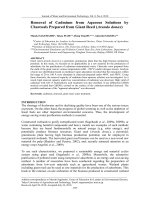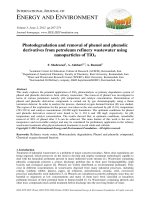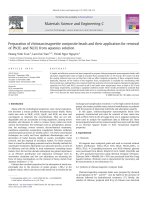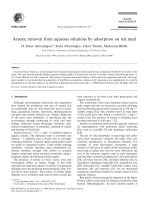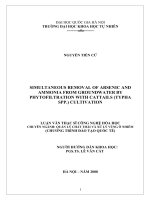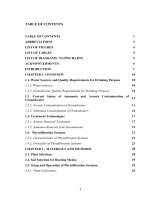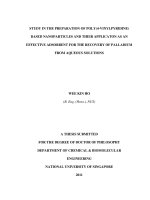Removal of nickel and methylene blue from aqueous solutions by steel slag as a low cost adsorbent
Bạn đang xem bản rút gọn của tài liệu. Xem và tải ngay bản đầy đủ của tài liệu tại đây (1.5 MB, 7 trang )
Physical sciences | Chemistry
Removal of nickel and methylene blue
from aqueous solutions by steel slag as a low cost adsorbent
Van Thuan Le1, Hoang Sinh Le1, Xuan Vu Tran2, Thi Kieu Ngan Tran2, Dang Quang Vo2, Bao Chau Tran2,
Quoc Phu Ngo2, Thị Xuan Thuy Le3*
1
Center for Advanced Chemistry, Institute of Research & Development, Duy Tan University
2
Faculty of Environmental and Chemical Engineering, Duy Tan University
3
Faculty of Environment, Da Nang University of Science and Technology
Received 3 April 2017; accepted 20 October 2017
Abstract:
Nowadays, wastewater from various industries contains a large number of
harmful heavy metals and coloring agents, which have to be removed to
restore the quality of the environment. In this study, the removal of nickel
ions (Ni2+) and methylene blue (MB) from the aqueous solution using steel
slag as a low cost adsorbent was investigated. The chemical and mineralogical
compositions, as well as the surface area of slag, were analyzed by using X-ray
fluorescence spectroscopy, X-ray diffraction, and the Brunauer-Emmett-Teller
method (BET). The effect of several important parameters such as contact
time, adsorbent dose, pH, temperature, and initial adsorbate concentration on
the adsorption process was studied systematically by batch experiments. The
adsorption data were well correlated with the Langmuir isotherm model by
all samples. The maximum adsorption capacity of the raw slag samples was
36.49 mg/g for Ni2+ and increased from 0.68 to 1.98 mg/g for MB after being
acid-activated. The determined thermodynamic parameters indicate that the
adsorption of Ni2+ and MB on steel slag is spontaneous in nature, endothermic
(for Ni2+), and exothermic (for MB).
Keywords: adsorption, dye, heavy metals, low cost adsorbent, steel slag, water
treatment.
Classification number: 2.2
Introduction
It is well known that water is a
precious and irreplaceable resource for
human and animals’ life [1]. However,
water pollution of heavy metals and
dyes, which are major contributors to
the contamination of water streams, has
been a serious environmental problem
in the recent years. The increasing water
contamination by heavy metal ions and
dyes has become a significant concern
for ecological systems and public health
because of their nonbiodegradable
property, bioaccumulation, and toxicity,
even at low concentrations [2]. Nickel is
one of the important toxic heavy metals
that is widely used in electroplating,
printing, storage-battery industries,
silver refineries, and production of some
alloys. High concentration of nickel
causes poisoning effects like lung, nose,
bone cancers, headaches, dizziness,
nausea, cyanosis, and extreme weakness
[3]. One of the high consuming materials
in the dye industry is MB, which is the
most commonly used substance for
dying cotton, wool, and silk [4]. The MB
can cause eye burns, nausea, vomiting,
diarrhea, dyspnea, tachycardia, cyanosis,
methemoglobinemia, and convulsions if
inhaled [5, 6]. Therefore, the treatment
of effluent, containing heavy metal
ions, and dyes such as nickel and MB,
is necessary due to their harmful effects
on humans.
Among the various methods
currently applied for removing heavy
metals and dyes from the water industry,
adsorption is the most widely used
method due to its merits of efficiency,
economy, and simple operation [7].
Different adsorbents have been used for
the removal of MB and nickel ions from
aqueous solutions, including graphene
[8, 9], bentonite [10], activated carbon
[4], perlite [11], pumice [12], and
hydroxyapatite [13, 14]. However, these
adsorbents are relatively expensive, and
this has restricted their application at
times.
Steel slag is the main by-product of the
iron and steel industry. A huge amount of
it is accumulated in the environment and
causes numerous ecological problems.
Therefore, determining the sustainable
usage of accumulated steel slag for
other purposes will bring economic and
environmental benefits. In the recent
years, steel slag has been reported as
potential adsorbent to remove pollutants
from waste water [15-19]. In this study,
steel slag was chosen as a low cost
adsorbent to remove nickel ions and
methylen blue dye. The main objective
of this work was to evaluate the removal
ability of steel slag and its activated
form for Ni2+ and MB under different
experimental conditions.
*Corresponding author: Email:
December 2017 • Vol.59 Number 4
Vietnam Journal of Science,
Technology and Engineering
7
Physical Sciences | Chemistry
Materials and methods
Materials and chemicals
The experiment material used in this
study was electric arc furnace (EAF) steel
slag obtained from a steelmaking plant
(Danang, Vietnam). The collected steel
slag was crushed and sieved to obtain
particles. Activated slag was obtained by
soaking raw crushed steel slag with 2 M
HCl for 24 hours at room temperature.
After that, the acid suspension was
filtered by vacuum filter and then, the
residue was washed with distilled water.
Finally, the sample was dried at 100˚C
for 12 hours and ground to a powder
state. Nickel sulfate hexahydrate and
methylen blue were purchased from
Merck. The reagents dimethylglyoxime
(99.00%), NaOH (99.95%), and HCl
(36.5%) were provided by Sigma
Aldrich. All other reagents used in this
study were analytical grade, and distilled
or double distilled water was used in the
preparation of all solutions.
initial concentrations and a certain
temperature. The pH of the solutions
was adjusted by adding 0.1 M aqueous
solutions of NaOH or HCl using a pH
meter InoLab Multi 9310. To ensure
homogeneous mixing, an orbital shaker
with an agitation speed of 150 rpm was
used throughout the experiment. Then,
the samples were centrifuged at 5000
rpm for 10 min. The concentrations of
the nickel ions and the MB dye before
and after adsorption were estimated
using an UV-visible spectrophotometer
(UV-VIS Ultrospec 8000). The effect
of the adsorbent dose was conducted
using 2.5-20 g/l of adsorbent. The effect
of pH was investigated over a pH range
of 2-8. The effect of contact time was
studied under different given contact
time between 5 min and 120 min.
The percentage removal (R%) and
the amount of adsorbed nickel ion
and MB dye were calculated using the
following equations:
Characterization of adsorbent
The chemical composition of the slag
was determined by X-ray fluorescence
spectroscopy (XRF) using a Philips PW
2404 instrument. The morphologies
of the samples were investigated by
scanning electron microscopy (SEM,
Hitachi S4800). The mineralogical
composition was analyzed by an
X-ray diffractometer Rigaku Ultima
IV (Japan), operating at 45 kV and
40 mA, using Cu-Kα radiation of λ =
0.15418 nm, 2θ ranging from 5 to 60°,
and step size 0.1o. Phase identification
was carried out by comparing the peak
positions of the diffraction patterns with
ICDD (JCPDS) standards. Surface area
of the slag was measured by the BET on
Micromeretics TriStar 3000 instrument.
R=
(1)
.
(2)
.
where: Co and Ce are the initial and
final concentrations of Ni2+ ions and
MB before and after the adsorption in
aqueous solution (mg/l); Qe is the amount
of Ni2+ and MB dye adsorbed by the slag
(mg/g); V is the volume of solution (l);
m is the mass of adsorbent (g).
Results and discussions
Characterization of sorbent
surface area and density of the steel
slag are 4.23 m2/g and 3.025 g/cm3,
respectively. Aqueous suspensions of
the slag have a high pH value (10.52)
because of great content of calcium
hydroxide (30.23 w%) and basic oxides
in it, which lead to a high capacity of the
slag to neutralize strong acidic media.
The mineralogical compositions of
slag samples were determined by the
XRD analysis, and obtained results
are given in Fig. 1. The analysis of the
diffraction patterns showed that both
slag samples are heterogeneous materials
consisting the following major crystalline
phases: larnite (Ca2SiO4), wuestite
(FeO), gehlentite (Ca2Al(AlSiO7)),
mullite (3Al2O3.2SiO2), and quartz
(SiO2). Other minor constituent phases
in the analyzed samples are very difficult
to identify because of the complexity
of the diffractograms. Additionally,
XRD patterns show that the peaks of
the activated slag are more intense and
clearer compared to the raw steel slag.
This may be because some impurities in
the raw slag have been removed when it
was soaked in the acid solution.
Morphology study
Figure 2 shows the morphologies
of the slag samples before and after
adsorption, as characterized by SEM.
It can be seen from the SEM images
that there is no significant change in
morphology of the slag samples before
and after adsorption of Ni2+ and MB.
Under SEM, the slag particles showed
irregular shapes with sharp edges about
0.5 µm to 2 µm in size.
(1)
(2)
Effect of initial solution pH
The
chemical
and
physical
The initial pH value of the adsorbate
characteristics of the steel slag are
solution
is one of the most important
presented in Table 1. The result
factors
influencing the adsorption
showed that the steel slag of this study
Batch studies
mainly contains calcium, iron, silicon, process due to its strong effect on the
Batch adsorption studies were magnesium, aluminum, manganese, surface charge, the surface binding
performed at different doses of adsorbent, and phosphorus compounds. The joint sites of the adsorbent, and the degree of
4. Effect of
adsorption
and MB
slagof adsorbate
.
ionization
andonto
species
[21].
initial pH, contact time, concentrationsFig.presence
of contact
calciumtime
oxideonand
alumina of nickel
of Ni2+ and MB. For each experiments, silicate compounds could facilitate the The effect of initial pH on the adsorption
The adsorption of MB on activated slagoccurred relatively quickly because ther
three replicates of the adsorbents (0.5 g) provision of negatively charged sites for process was studied in the range from
o nonactivatedslag. T he amount o
more
active sites
on the
surface
tothe
2 to 8 at 25±2
C, the adsorbent dosage
were mixed with 50 ml solutions of Ni2+/were
cation
exchange
reactions
with
metal compared
MB
dy
e
removed
by
the
activated
slag
also
rose
up
to
more
than
after 5 min, and
of 60
min,99%
50 ml
MB in 150 ml conical flasks at different ions in the aqueous solution [20]. The of 0.5 g, contact time
remained invariable untilthe adsorptionattained a balancedstatus.
8
Effect of adsorbent dose
Vietnam Journal of Science,
Technology and Engineering
December 2017 • Vol.59 Number 4
To select the best-required dose for the scale-up and to design large-scale
equipments, the effect of adsorbent dose on MB dye andNi 2+ removal was investigated
Physical sciences | Chemistry
Table 1. The chemical and physical characteristics of the slag.
Chemical composition (w%)
CaO
Fe2O3
SiO2
Al2O3
MnO
MgO
P2O5
30.23
28.57 22.19
6.68
4.17
2.39
2.20
BET surface
area (m2/g)
Density
(g/cm3)
pH
4.23
3.025
10.52
Q: quartz
W: wuestite
L: larmite
M: mullite
G: gehlenite
Fig. 1. XRD patterns of slag samples.
Fig. 2. SEM images of slag samples: (A) before adsorption, (B) after Ni2+
adsorption, and (C) after MB adsorption.
of initial Ni2+ and MB solutions with a
concentration of 200 mg/l and 5 mg/l,
respectively. Fig. 3 shows the effect of
the initial pH on the adsorption of Ni2+
ions and MB onto different forms of
slag. It can be seen that the MB removal
percentage of both slag samples had no
significant change and reached 99.9%
for the activated slag sample at the whole
pH range. While the raw slag can remove
98.6-99.9% of MB from the aqueous
solution at pH 2-6 and its removal ability
insignificantly decreased to 96.1% at pH
7-8. For Ni2+, the percentage removal
generally increased with increasing the
pH of the solution. It can reach 77.5%
at pH 2 and increase to 98.3% at the pH
range of 5 to 8 for raw slag sample. The
removal percentage of Ni2+ by activated
slag in the range of pH 2-8 was 12.323.5%, which is about 4-5 times lower
than that by raw slag. This can be due to
the decreased alkalinity of the slag when
it was activated by acid. Therefore, the
experiments of nickel adsorption onto
the activated slag were not conducted
any further.
At a lower pH than 5.0, the Ni2+ ion
adsorption capacity of slag was low
due to the increased concentration of
hydronium (H3O+) ions, which compete
for Ni2+ binding sites on the slag surface.
The increase in pH resulted in a reduction
in H3O+ ions; the adsorption sites were
available to be occupied by more Ni2+
ions than H3O+ ions. At an alkaline pH,
there was hydroxyl group abundance on
the slag surface, which promoted the
adsorption of metal cations. However, at
pH values higher than 7.0, precipitation
usually occurs simultaneously between
Ni2+ ions and hydroxide ions, and
could lead to inaccurate interpretation
of adsorption [22]. Based on the above
results, the optimum pH values of 5.0
and 6.0 were selected for the adsorption
study regarding the removal of Ni2+ and
MB dye, respectively.
Effect of equilibrium time
Fig. 3. Effect of pH on Ni2+ and MB adsorption onto slags.
The determination of the contact
time between adsorbent and adsorbate
required for the system to reach
December 2017 • Vol.59 Number 4
Vietnam Journal of Science,
Technology and Engineering
9
Physical Sciences | Chemistry
equilibrium is important to determine
the possible discrimination order in the
behavior of the slag for Ni2+ and MB
dye removal. The effect of contact time
on adsorption of Ni2+ and MB onto slag
samples was carried out at different
contact times ranging from 5 min to
120 min at 25±2oC, adsorbent dosage of
0.5 g, the selected optimum pH values,
and 50 ml of adsorbate solutions (200
mg/l for Ni2+ and 5 mg/l for MB). As
shown in Fig. 4, over 97% of Ni2+ ions
and MB was adsorbed on the slag phase
after only 10 min of the equilibrium
periods. The adsorption of the Ni2+
and MB dye by the raw slag exhibits a
similar trend. The percentage removal
increased with a lapse of contact time,
and equilibrium was reached after 30
min. Moreover, it can be seen that the
adsorption of Ni2+ and dye on raw slag
had taken place in two stages where the
first stage is faster than the second stage.
This phenomenon can be confirmed by
the slope of adsorption line which had
value in the first step of the adsorption
process higher than the second. The
initial rapid stage can be associated
with the presence of the large number of
binding sites at exterior surface, which
are being fully available at the initial
stage of adsorption process. When the
exterior adsorption sites become filled
with adsorbates, the adsorbate ions then
moved with slow rate from the exterior
to the interior.
The adsorption of MB on activated
slag occurred relatively quickly because
there were more active sites on the
surface compared to the nonactivated
slag. The amount of MB dye removed by
the activated slag also rose up to more
than 99% after 5 min, and remained
invariable until the adsorption attained a
balanced status.
Effect of adsorbent dose
To select the best-required dose for
the scale-up and to design large-scale
equipments, the effect of adsorbent
dose on MB dye and Ni2+ removal was
investigated. The effect of the dose on
the adsorption was studied by varying
the amount of adsorbent from 0.25 to 1
g in 50 ml of adsorbate solutions with
10
Vietnam Journal of Science,
Technology and Engineering
Ni2+ - slag
MB - slag
MB - activated slag
Fig. 4. Effect of contact time on adsorption of nickel and MB onto slag.
MB - slag
Ni2+ - slag
MB - activated slag
Fig. 5. Effect of sorbent dose on adsorption of Ni2+ and MB onto slag.
initial concentrations of 200 mg/l (for
Ni2+) and 5 mg/l (for MB) at a room
temperature of 25oC, optimum pH, and a
contact time of 30 min. The relationship
between the removal percentage of Ni2+
ions and MB and the adsorbent dose is
shown in Fig. 5.
It is shown that the removal efficiency
of Ni2+ ions and MB increased with
increasing the adsorbent dose for all the
slag samples due to the availability of
more surface area on the adsorbent. This
means that there was a small surface area
for the attachment of the adsorbate ions at
a low adsorbent dose, resulting in the low
efficiency of Ni2+ ions and MB removal.
However, as the adsorbent amount
increased, more sites became available
for the attachment; hence, the removal
December 2017 • Vol.59 Number 4
capacity of the adsorbent increased. The
increase in the slag dose from 2.5 to 5 g/l
resulted in an increase in the adsorption of
Ni2+ from 70.6 to 75.7% and of MB from
86.7 to 92.8% for the raw slag samples
and from 95.7 to 98.9% for the activated
slag samples. When the adsorbent dose
was sufficient (> 10 g/l), over 99% of
adsorbates could be removed. Thus, the
complete removal was possible with an
adsorbent dose of 10 g/l.
Effect of initial concentration
The effect of the initial concentration
on the removal efficiency and adsorption
capacity of Ni2+ ions and MB on the slag
samples at room temperature of 25oC, an
adsorbent dose of 10 g/l, optimum pH, and
contact time of 30 min is shown in Fig. 6.
Physical sciences | Chemistry
Fig. 6. Effect of initial concentration on (A) Ni2+ and (B) MB adsorption.
Fig . 5. Effect of sorbent dose on adsorption of Ni 2+
Fig. 7. Langmuir plots for Ni2+ and MB adsorption on slag samples.
It is shown that the effect of the
initial concentration of Ni2+ and MB on
their removal efficiency has a similar
tendency. The percentage of removal
was nearly 100% at a low concentration
of Ni2+ (< 250 mg/l) and MB dye (< 6
mg/l). With the increase of the initial
concentration of Ni2+ ions from 50 to
400 mg/l and of MB from 2 to 40 mg/l,
the removal efficiency decreased from
about 100 to 88.2, 34.5, and 50.02%
for Ni2+, MB (on the raw slag) and MB
(on the activated slag), respectively.
The adsorption capacity increased from
about 4.8 to 35.3 mg/g for Ni2+ and
from 0.2 to 1.97 mg/g for MB. At low
initial concentrations, molecules of the
adsorbates had more chance to react
with the available active sites on the
slag samples, resulting in an increase in
the percentage removal. The decrease
in the removal percentage at high
concentrations of adsorbates can be
explained that all the slag samples were
limited by the adsorption sites; thus, the
adsorption of Ni2+ and MB becomes
restricted by the saturation of these
adsorption sites [23].
Adsorption isotherms
The determination of the adsorption
isotherm is important to indicate how
adsorbent molecules were distributed
between the liquid and the solid phase,
and could be accurately used for design
purposes and optimization of economical
equipments. In this study, the Langmuir
and Freundlich isotherm models were
used to interpret equilibrium data of
Ni2+ and MB(II) adsorption on the slag
by utilizing the adsorption data obtained
from the effect of initial concentrations.
However, the experimental data were
not correlated to the Freundlich model.
Hence, only the results of the equilibrium
data analysis using the Langmuir model
are presented. The Langmuir isotherm
considers the adsorbent surface as
homogeneous
identical
sites inon ( A ) Ni 2+ an
Fig . 6. Effectwith
of initial
concentration
terms of energy, and can be described by
the following equation [24]:
(3)
where: Ce is the equilibrium concentration
of Ni2+/MB (mg/l), Qe is the amount
of Ni2+ or MB
R L =adsorbed at equilibrium
(mg/g), Qm is the maximum adsorption
capacity of Ni2+/MB (mg/g), and K is
Where,
C o(l/mg).
is theThe
initial
concentration
the Langmuir
constant
value
of Qadsorption
was calculated
using (L/mg).
Equation 2.
constant
e
Qm and K were calculated from a linear
isothe
plot of Ce/QFigure
against6Cshows
with athe
slopeadsorption
and
e
e
The Langmuir
(C em/Qand
C m.e)K),
plots and the
an intercept
equal to 1/Q
1/(Q
e vs.
2+
respectively.
The
constant
separation
for Ni and MB adsorption are shown in Fig.
factor RL, whose value indicates the
shape of the Langmuir isotherm, and
predicts if an adsorption system is
December 2017 • Vol.59 Number 4
Vietnam Journal of Science,
Technology and Engineering
11
Fig . 6. Effect of initial concentration on ( A ) Ni 2+ and ( B ) MB adsorption .
Physical Sciences | Chemistry
(3)
favourable or unfavourable, is calculated
by the following equation [25]:
RL =
(4)
Table 2. Isotherm parameters for the adsorption of Ni2+ and MB onto slag.
Adsorbate-Adsorbent
Qm (mg/l)
Ni - slag
MB - slag
2+
K (l/mg)
R2
RL
36.49
0.62
0.9987
0.0040
0.68
24.90
0.9998
0.0020
0.9996
0.0013
(4)
where:
Co is the
initial
of
Where,
C o is
the concentration
initial concentration
of MB
adsorbate
(mg/l), and
- act. slag
1.98K is the Langmuir
19.73
adsorbate
(mg/l),
and
K
is
the
Langmuir
adsorption constant (L/mg).
adsorption constant (l/mg).
2+
Figure 66 shows
Figure
shows the
theadsorption
adsorption isotherm ofNi and MB dye on the slag samples.
2+ /Q vs. C ) plots and the
MB - slag isotherm
Theisotherm
Langmuir
(C
tting parameters of the Langmuir
e MB edye on the
of Ni e and
2+
2+
Langmuirare
(Ceshown
/Qe vs. in Fig. 7 and Table 2, respectively.Ni - slag
and MBThe
adsorption
for slag
Ni samples.
MB - activated slag
Ce) plots and the fitting parameters of
2+
the Langmuir isotherm for Ni and MB
adsorption are shown in Fig. 7 and Table
2, respectively.
As a result, the correlation
coefficients obtained from the Langmuir
equation for the adsorption of Ni2+
and MB dye on all slag samples were
found to be from 0.9996 to 0.9998,
indicating that the experimental data
were well correlated with the Langmuir
model. This means that the adsorption
process was mainly monolayer on a
homogeneous adsorbent surface. The Qm
values for Ni2+ and MB adsorption on
the non-activated slag were 36.49 mg/g
and 0.68 mg/g, respectively. While the
maximum adsorption capacity of MB on
the activated slag was 1.98 mg/g, about
2 times higher than that of the nonactivated slag sample. The enhancement
in the adsorption capacity of the acidactivated slag compared with the raw
slag may be due to an increase in the
number of active adsorption sites by acid
treatment.
Fig. 8. Plot of lnKc as a function of reciprocal of temperature (1/T) for the
adsorption of Ni2+ and MB by slag.
Table 3. Calculated thermodynamic parameters for Ni2+ and MB adsorption
on slag.
∆Go (kJ/mol)
Vietnam Journal of Science,
Technology and Engineering
R2
298K
303K
308K
313K
Ni2+ - slag
-16.76
-19.59
-23.56
-29.96
242.10
866.12
0.940
MB - slag
-21.16
-18.76
-17.52
-17.12
-100.87
-269.12
0.897
MB - act. slag
-23.35
-21.05
-19.61
-17.78
-131.36
-362.99
0.991
on the slag samples, the adsorption
experiments were performed at different
temperatures from 298 to 313 K. The
equilibrium adsorption coefficient (Kc)
for the adsorption process was calculated
with the Equation 5 [27]:
The value of the separation factor,
RL, indicates the adsorption nature of
the adsorbate with the adsorbent. The
cad
(5)
Kc
adsorption process is unfavorable if RL
ce
> 1, favorable if 0 < RL < 1, linear if RL
= 1, and irreversible if RL = 0 [26]. In where: Cad and Ce are equilibrium
the present study, the values of RL fall concentrations (mg/l) of Ni2+ and MB
cad slag samples and in the solution,
in between 0 and 1, and have confirmed K on the
c
respectively.
The
thermodynamic
that all slag samples are favorable for
ccade
Kcparameters
2+
c
o
such
as
change
in Gibbs
Ni and MB adsorption under the
e
∆ Go), =
RTlnK
oc
free
energy
(∆G
enthalpy
(∆H
), and
experimental conditions.
entropy (∆So) are calculated using the
Evaluation
of
adsorption
∆
∆
following
o equations [28]:
thermodynamics
lnKc =
∆ Go = - RTlnK
c
∆ G = - RTlnKc
(6)
To evaluate the thermodynamic
∆
∆
2+
parameters of Ni and MB adsorption
(7)
lnKc = ∆ -∆
lnKc =
-
12
∆So
(J/mol/K)
∆Ho
(kJ/mol)
Samples
December 2017 • Vol.59 Number 4
where: R is the universal gas constant
(8.314 J/mol/K), T is the absolute
temperature (K). ∆Ho and ∆So were
calculated from the slope -∆Ho/R and
intercept ∆So/R of the linear variation
of ln Kc with the reciprocal of the
temperature (1/T), as shown in Fig. 8. The
obtained values of the thermodynamic
parameters are presented in Table 3.
As can be observed from Table 3,
the negative values of Go for nickel ions
and MB adsorption at all temperatures(5)
(5)
indicate that the adsorption mechanism
is a general spontaneous process and
thermodynamically favorable [29]. The
calculated thermodynamic parameters
for MB adsorption on all the slag
(6)
samples were negative. The negative
values of ∆Ho provide the exothermic
(7)
(6)
(7)
Physical sciences | Chemistry
nature of the adsorption process. The
negative ∆So indicates the decrease of
the degree of freedom at the solid-liquid
interface during the adsorption of MB on
slag. For nickel adsorption, the standard
enthalpy and the entropy values were
obtained as 242.10 kJ/mol and 866.12 J/
mol/K, respectively. The positive values
of ∆Ho and ∆So reflect that the adsorption
of Ni2+ by the slag is an endothermic
process, and the randomness at the solidliquid interface during the adsorption
increases. This type of absorption can
be explained in terms of the magnitude
of ∆Ho. Physisorption generally has
low enthalpy values of 20-40 kJ/mol,
while the enthapy of chemisorption
lies in a range of 200-400 kJ/mol [30].
Therefore, nickel adsorption onto steel
slag surface in the main can be attributed
to a chemical adsorption process.
Conclusions
The steel slag was found to be a
cheap material for the removal of Ni2+
and MB from aqueous solutions. The
removal efficiency of Ni2+ and MB
by the slag strongly depended on their
initial concentration, contact time, initial
pH, and adsorbent dose. The removal
percentage of Ni2+ and MB dye was
found to increase with an increase in the
contact time, and the adsorbent dose was
found to decrease with an increase in
the initial adsorbate concentration. The
optimal pH for Ni2+ removal was 5.0,
which was lower than that for MB (pH
6.0). The adsorption of Ni2+ and MB dye
on the steel slag saturated within 30 min
and the adsorption processes could be
well described by the Langmuir isotherm
model, with maximum adsorption
capacity of 36.49 mg/g for Ni2+ and 1.98
mg/g for MB. The activated slag had
an adsorption capacity of about 2 times
higher than the non-activated slag. The
thermodynamic parameters indicate that
the adsorption process is spontaneous in
nature, thermodynamically favorable,
endothermic (for Ni2+), and exothermic
(for MB). The results of this study show
that the steel slag, a residue from steel
plants that is readily available and easy
to obtain at low cost, can be used as an
effective adsorbent for the removal of
Ni2+ ions and MB dye from wastewater.
REFERENCES
[1] R. Sivashankar, A.B. Sathya, K. Vasantharaj,
V. Sivasubramanian (2014), “Magnetic composite an
environmental super adsorbent for dye sequestration
- A review”, Environmental Nanotechnology,
Monitoring & Management, 1(2), pp.36-49.
[2] A.T. Jan, M. Azam, M. Siddiqui, K. Ali,
I.A. Choi, Q.M.R. Haq (2015), “Heavy metals and
human health: mechanistic insight into toxicity and
counter defense system of antioxidants”, Int. J. Mol.
Sci., 16(12), pp.29592-29630.
[3] L. Pivarčiová, O. Rosskopfová, M. Galamboš,
et al. (2014), “Sorption of nickel on chitosan”, J.
Radioanal. Nucl. Chem., 300, pp.361-366.
[4] J. Yang, K. Qiu (2010), “Preparation of
activated carbons from walnut shells via vacuum
chemical activation and their application for
methylene blue removal”, Chem. Eng. J., 165(1),
pp.209-217.
[5] S. Cheng, L. Zhang, H. Xia, J. Peng, J.
Shu, C. Li, X. Jiang, Q. Zhang (2017), “Adsorption
behavior of methylene blue onto waste-derived
adsorbent and exhaust gases recycling”, RSC Adv.,
7, pp.27331-27341.
[6] M.M. Swamy, B.M. Nagabhushanac,
R.H. Krishnac, N. Kottamc, R.S. Raveendrad, P.A.
Prashanth (2017), “Fast adsorptive removal of
methylene blue dye from aqueous solution onto a
wild carrot flower activated carbon: isotherms and
kinetics studies”, Desalination Water Treat., 71,
pp.399-405.
[7] S. Wang, Z.H. Zhu (2006), “Characterisation
and environmental application of an Australian
natural zeolite for basic dye removal from aqueous
solution”, J. Hazard. Mater., 136, pp.946-952.
[8] L. Tonghao, L. Yanhui, D. Qiuju, S. Jiankun,
J. Yuqin, Y. Guangming, W. Zonghua, X. Yanzhi, Z.
Wei, W. Kunlin, Z. Hongwei, W. Dehai (2012),
“Adsorption of methylene blue from aqueous solution
by graphene”, Colloid. Surf. B: Biointerfaces, 90,
pp.197-203.
[9] N. Fahimeh, M. Omid, R. Mostafa, A.
Mohammad, T. Inderjeet, A. Shilpi, K.G. Vinod
(2015), “Thermodynamics of the adsorption of
nickel ions from aqueous phase using graphene
oxide and glycine functionalized graphene oxide”,
J. Mol. Liq., 208, pp.106-113.
[10] S. Hong, C. Wen, J. He, F.X. Gan, Y.S. Ho
(2009), “Adsorption thermodynamics of methylene
blue onto bentonite”, J. Hazard. Mater., 167,
pp.630-633.
[11] M. Doğan, M. Alkan, Y. Onganer (2000),
“Adsorption of methylene blue from aqueous solution
onto perlite”, Water, Air & Soil Pollut., 120(3-4),
pp.229-248.
[12] F. Akbal (2005), “Adsorption of basic dyes
from aqueous solution onto pumice powder”, J.
Colloid and Interface Sci., 286(2), pp.455-458.
[13] O. Rosskopfova, M. Galamboš, L. Pivarčč
iová, M. čČaplovičč ová, P. Rajec (2013), “Adsorption
of nickel on synthetic hydroxyapatite from aqueous
solutions”, J. Radioanal. Nucl. Chem., 295, pp.459465.
[14] A. Khadija, E.L. Abdeslam, B.B. Bouari, B.
Lahcen (2016), “Removal of methylene blue from
water using hydroxyapatite submitted to microwave
irradiation”, J. Water Resource Prot., 8, pp.358-371.
[15] W. Cha, J.W. Kim, H.C. Choi (2006),
“Evaluation of steel slag for organic and inorganic
removals in soil aquifer treatment”, Water Res., 40,
pp.1034-1042.
[16] S. Guanling, W. Yue, C. Xiao, H. Wenhua,
W. Qunhui (2014), “Adsorption performance of
heavy metal ions between EAF steel slag and
common mineral adsorbents”, Desalin. Water
Treat., 52, pp.7125-7132.
[17] S.V. Dimitrova, D.R. Mehanjiev (2000),
“Interaction of blastfurnace slag with heavy metal
ions in water solutions”, Water Res., 34, pp.19571961.
[18] X.J. Xue, S.P. Wu, M. Zhou (2013),
“Adsorption characterization of Cu(II) from aqueous
solution onto basic oxygen furnace slag”, Chem.
Eng. J., 231, pp.355-364.
[19] C. Oh, S. Rhee, M. Oh, J. Park (2012),
“Removal characteristics of As(III) and As(V) from
acidic aqueous solution by steel making slag”, J.
Hazard. Mater., 213-214, pp.147-155.
[20] A.S.A. Aziz, L.A. Manaf, H.C. Man, N.S.
Kumar (2014), “Equilibrium studies and dynamic
behavior of cadmium adsorption by palm oil boiler
mill fly ash (POFA) as a natural low-cost adsorbent”,
Desalin. Water Treat., 9, pp.1-13.
[21] Z. Lei, L.I. Yi-jun, Y.A.N. Xiang-bin (2008),
“Diffusion model and empirical study of the multigeneration products based on competition”, Systems
Engineering - Theory & Practice, 28, pp.84-92.
[22] E. Ahmet, T. Nüket, A. Tülin, B. Seda,
D. Ayse (2012), “Removal of Ni2+ ions by histidine
modified chitosan beads”, Chem. Eng. J., 210,
pp.590-596.
[23] Z. Ryu, J. Zheng, M. Wang, B. Zhang
(1999), “Characterization of pore size distributions
on carbonaceous adsorbents by DFT”, Carbon,
37(8), pp.1257-1264.
[24] I. Langmuir (1916), “The constitution and
fundamental properties of solids and liquids”, J.
Amer. Chem. Soc., 38, pp.2221-2295.
[25] A. Bhatnagar, A.K. Jain (2005), “A
comparative adsorption study with different
industrial wastes as adsorbents for the removal of
cationic dyes from water”, J. Colloid. Interface Sci.,
28(1), pp.49-55.
[26] D. Solairaj, P. Rameshthangam,
P.
Srinivasan (2016), “Adsorption of methylene blue,
bromophenol blue, and coomassie brilliant blue by
a-chitin nanoparticles”, J. Adv. Res., 7, pp.113-124.
[27] D.M. Han, G.Z. Fang, X.P. Yan (2005),
“Preparation and evaluation of a molecularly
imprinted sol-gel material for on-line solid-phase
extraction coupled with high performance liquid
chromatography for the determination of trace
pentachlorophenol in water samples”, J. Chromatogr.
A, 1100, pp.131-136.
[28] M.V. Dinu, E.S. Dragan (2010),
“Evaluation of Cu2+, Co2+ and Ni2+ ions removal from
aqueous solution using a novel chitosan/clinoptilolite
composite: kinetics and isotherms”, Chem. Eng. J.,
160, pp.157-163.
[29] G. Sheng, S. Wang, J. Hu, Y. Lu, J. Li, Y.
Dong, X. Wang (2009), “Adsorption of Pb(II) on
diatomite as affected via aqueous solution chemistry
and temperature”, Colloids Surf. A: Physicochem.
Eng. Aspects, 339, pp.159-166.
[30] B. Das, N.K. Mondal, R. Bhaumik, P. Roy
(2014), “Insight into adsorption equilibrium, kinetics
and thermodynamics of lead onto alluvial soil”, Int.
J. Environ. Sci. Technol., 11, pp.1101-1114.
December 2017 • Vol.59 Number 4
Vietnam Journal of Science,
Technology and Engineering
13
